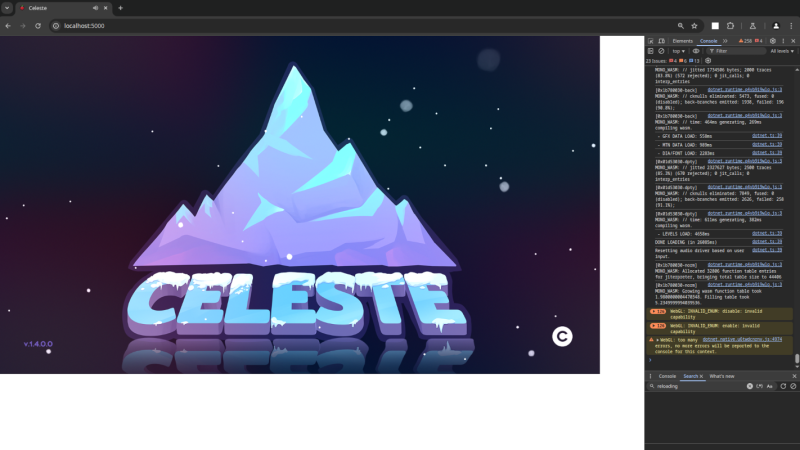Arguably, the golden age of browser gaming occurred in the 00s mostly revolving around Adobe Flash. This was an era with high creativity and a low barrier of entry, and also decentralized from gatekeeping app stores. Sadly, these times have passed us by as the security concerns around Flash led to its discontinuation and most casual gamers have migrated to the app store for their fix. But that doesn’t stop some from continuing to bring gaming to the browser, even if those games were never intended for it in the first place like this browser port of Celeste.
Celeste is an indie platformer where the player climbs a mysterious mountain while confronting her inner struggles. Originally meant for consoles and PC, a group of friends including [velzie], [bomberfish], and [Toshit] aka [r58Playz] took this as a challenge especially after seeing someone else’s half finished web port of this game. Most of the build revolves around WebAssembly (wasm) and around “cursed” .NET runtime hacks which also allow the port to run the community-made Everest mod loader. It uses a multithreaded and JIT compiling version of mono-wasm backported from .NET 10 to .NET 9 to maximize performance. The team actually first started by porting Terraria to the browser, and then moved on to this Celeste port from there.
The port of Celeste can be played here, and their port of Terraria is also available, although may not support a ton of Hackaday traffic so some patience is advised. There are also GitHub repositories for Celeste and Terraria as well. With impressive ports of relatively modern games moving into the browser, perhaps we’re entering a new golden age of browser gaming; we’ve also seen things like Minecraft implemented in only HTML and CSS lately as well.
















C# in the browser is not what I call a good idea. .NET in the browser is a bad idea. a modified version of the now abandoned mono is a terrible idea.
The rhetorical question I have (because I know and hate the answer) is why they hell do people keep porting stuff to run in a browser? Do people have no sense?!
Why? Regardless of which runtime is used, everything will be running on top of sandboxed wasm, so security shouldn’t be a concern (in theory).
The only concern should be performance, which tends to improve over time.
Typing an address into a browser and having access to a complete and complex game (as flash did in its time, and as wasm does today) is a feat of accessibility, and it was one of the cornerstones of the current state of the game development industry.
Because everybody’s got one. You wouldn’t believe the number of kids who regularly play a hacked WebAssembly port of Minecraft, because their only computer is a Chromebook.
Because it’s fun to see things run in-browser that were never meant to run in-browser. Same reason people port Doom to everything.
Celeste is small enough to be embedded in a PNG. They could emulate an entire Pico8 in 1GB RAM. What am I missing?
Celeste (2018), not the 2015 Pico-8 version.
The browser languages are Turing complete and has enough RAM and performance to do interesting things. From that point of view, nothing is actually impressive. But it’s still neat when it’s made. And someone has to go to the effort of making it.
Celeste is about 1.2GB, so you’re not wrong but also that’s a really big PNG.
Pico-8 isn’t really related, it’s a toy engine for super lo-fi minigames, not fully developed commercial games.
Years ago Humble Bundle had at least one bundle with several games you could play in webassembly, including FTL and Dustforce. Humble Mozilla Bundle: Powered by asm.js was the name of it, I guess the gimmick was games you could play in Firefox. I don’t actually see the bundle in my purchases anymore (it was in 2014) but the games I remember from it can still be launched from the library view.
“Arguably, the golden age of browser gaming occurred in the 00s mostly revolving around Adobe Flash. This was an era with high creativity and a low barrier of entry, and also decentralized from gatekeeping app stores. ”
I remember some pretty interesting web sites as well. Now it’s all the new web technologies to duplicate it.
Ugh, I hated flash sites. Games were one thing, but ‘creative’ navigation controls and site layout were the bane of the 2000s Web. And yes, it looks like the ‘modern web’ is doing its damndest to replicate the mistakes of the past with novel layouts, animations, and general counter-intuitive annoyances.
Guess what? I’m not invested enough in your content or ideas to spend the mental resources necessary to sort out your ugly and annoying UI. Elements popping in and out as I move around? No clear navigation controls or ToC? Naw. Solution now is the same as it was back then – close tab, and move on.
But were there tabs back then?
If you ran Firefox
IMHO, by now browser became Yet Another GUI on top of the OS GUI, so just why not.
https://www.youtube.com/watch?v=rmQFcVR6vEs